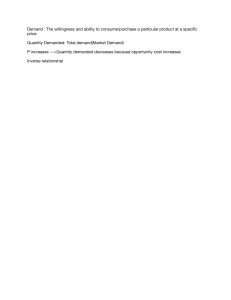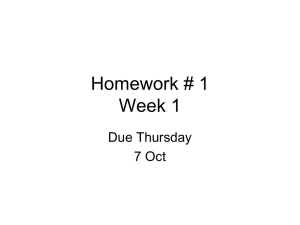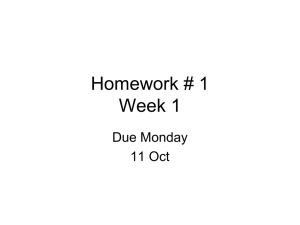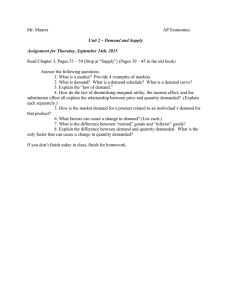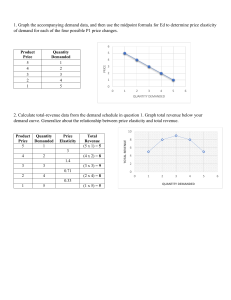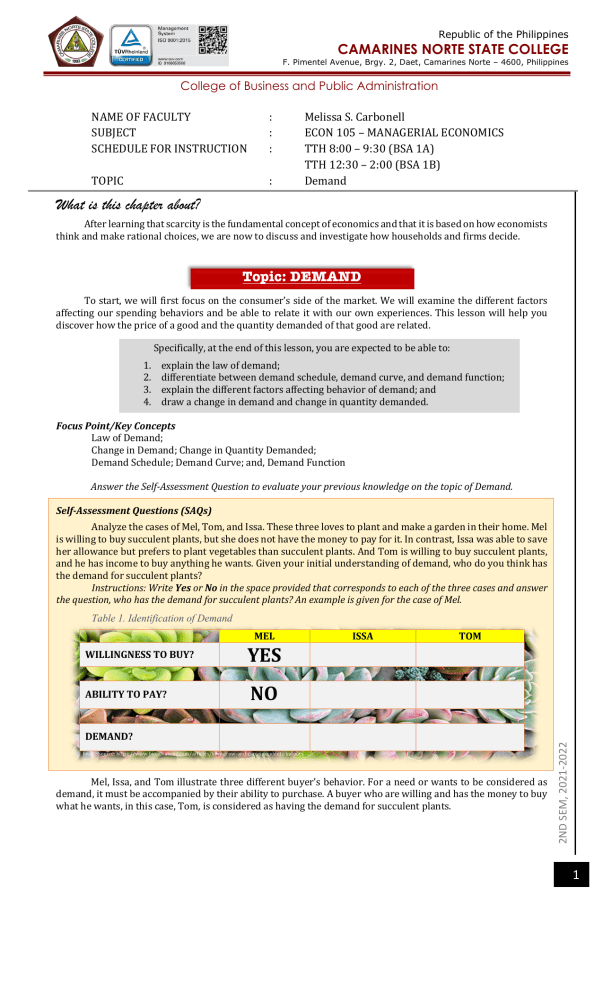
Republic of the Philippines CAMARINES NORTE STATE COLLEGE F. Pimentel Avenue, Brgy. 2, Daet, Camarines Norte – 4600, Philippines College of Business and Public Administration NAME OF FACULTY SUBJECT SCHEDULE FOR INSTRUCTION : : : TOPIC : Melissa S. Carbonell ECON 105 – MANAGERIAL ECONOMICS TTH 8:00 – 9:30 (BSA 1A) TTH 12:30 – 2:00 (BSA 1B) Demand What is this chapter about? After learning that scarcity is the fundamental concept of economics and that it is based on how economists think and make rational choices, we are now to discuss and investigate how households and firms decide. Topic: DEMAND To start, we will first focus on the consumer’s side of the market. We will examine the different factors affecting our spending behaviors and be able to relate it with our own experiences. This lesson will help you discover how the price of a good and the quantity demanded of that good are related. Specifically, at the end of this lesson, you are expected to be able to: 1. 2. 3. 4. explain the law of demand; differentiate between demand schedule, demand curve, and demand function; explain the different factors affecting behavior of demand; and draw a change in demand and change in quantity demanded. Focus Point/Key Concepts Law of Demand; Change in Demand; Change in Quantity Demanded; Demand Schedule; Demand Curve; and, Demand Function Answer the Self-Assessment Question to evaluate your previous knowledge on the topic of Demand. Self-Assessment Questions (SAQs) Analyze the cases of Mel, Tom, and Issa. These three loves to plant and make a garden in their home. Mel is willing to buy succulent plants, but she does not have the money to pay for it. In contrast, Issa was able to save her allowance but prefers to plant vegetables than succulent plants. And Tom is willing to buy succulent plants, and he has income to buy anything he wants. Given your initial understanding of demand, who do you think has the demand for succulent plants? Instructions: Write Yes or No in the space provided that corresponds to each of the three cases and answer the question, who has the demand for succulent plants? An example is given for the case of Mel. Table 1. Identification of Demand MEL TOM YES ABILITY TO PAY? NO DEMAND? NO Image Source: https://www.bioadvanced.com/articles/how-grow-and-care-succulents-indoors Mel, Issa, and Tom illustrate three different buyer’s behavior. For a need or wants to be considered as demand, it must be accompanied by their ability to purchase. A buyer who are willing and has the money to buy what he wants, in this case, Tom, is considered as having the demand for succulent plants. 2ND SEM, 2021-2022 WILLINGNESS TO BUY? ISSA 1 ECON 105 – MANAGERIAL ECONOMICS DEMAND AND ITS ATTRIBUTES 1.1. Law of Demand In the activity above, you are introduced to the two major components of demand: 1) a buyer’s willingness to buy; and, 2) ability to pay. Thus, we know that: DEMAND It refers to the various quantities of goods or services that consumers are willing to purchase in the market at all possible prices during a specific period. To further understand demand, we will use the case of Tom, where he exhibited the two most essential components of demand towards succulent plants. Refer to Table 2 to understand Tom’s buying behavior. Suppose that the price of a succulent plant is P150, Tom is willing to buy three (3) pieces of succulent plants. However, when the price increase to P450, Tom reduces his demand and is only willing to buy one (1) piece of succulent plant. Table 2. Tom’s Demand for Succulent Plants Quantity of Succulent plants Price demanded/bought P 150 P 300 P 450 This behavior illustrates the Law of Demand, which states that the quantity purchased varies inversely with price, holding other factors constant. In other terms, as shown in Figure 1, where the price of a good or service rises, the quantity demanded declines and vice versa. Take note that there is a market when there is a need for a good or service. A market is a place of sale between buyers and sellers through trading or exchanging goods or services. We have already addressed two markets, product and factor markets, in the previous chapter. In analyzing demand, we will consider the three most commonly used methods, such as demand schedule, demand curve, and demand function. Consider the market demand for succulent plants, as shown in Table 3. Market demand involves the sum of all individual demand for particular products or services. Imagine how the demand for a succulent plant might vary in a given week depending on the price: Table 3. Market Demand for Succulent Plants Quantity of succulent Point Price per plant plants demanded DEMAND A P 450 100 SCHEDULE B 400 200 It is a table that shows how C 350 300 much of a good or service D 300 400 consumers are both willing and able to buy at different E 250 500 prices. F 200 600 G 150 700 H 100 800 Table 3 is an example of a demand schedule. It shows the different prices and the corresponding quantities for the demand for succulent plants in a week. For instance, at a given price of P450, the buyers are BY: MSCARBONELL 2ND SEM, 2021-2022 1.2. Demand Schedule and Demand Curve 2 ECON 105 – MANAGERIAL ECONOMICS DEMAND AND ITS ATTRIBUTES willing to purchase only 100 pieces of succulent plants. However, at the cost of P100, they are willing to buy 800 pieces of succulent plants. Please remember that as the price goes up (down), the quantity of succulent plants being purchased by the consumer goes down (up). It implies the inverse relationship between the price and the quantity demanded and is consistent with the Law of Demand discussed above. When the relationship between the prices of the goods and services is shown in a tabular form, it is called the demand schedule. If you plot the above data in a graph, with quantity on the horizontal (X) axis and the price on the vertical (Y) axis, you will derive a demand curve, as shown in Figure 2. A demand curve is a graph showing the relationship between a good/service price and its quantity demanded. 450 Price per plant 400 350 300 250 200 150 100 A demand curve has a negative slope; thus, it slopes downward from left to right. The negatively sloped or downward sloping indicates the inverse relationship between price and quantity demanded. That is when the price of the commodities decreases (increases), more(less) goods will be bought by the consumer. A B C D E F G H D0 50 0 Please remember that demand curves vary for each product. It can be relatively steep or flat, or they may be straight or curved. Demand curves usually embody the law of demand. 100 200 300 400 500 600 700 800 900 Quantity of succulent plants demanded Figure 2. Demand Curve of Succulent Plants Let us assume that the price per plant is at price P 250. At this price level, the quantity demanded for a succulent plant is at 500, and therefore demand will be at point E along the demand curve D0. However, if the price will increase to P 450, the quantity demanded will decrease to 100, and demand will move upward towards point A along the same demand curve. This brings us now to the Law of Demand which states that ‘if the price goes UP, the quantity demanded of a good will go DOWN.’ Conversely, ‘if the price goes DOWN, the quantity demanded of a good will go UP, ceteris paribus.’ The reason for this is because consumers always tend to Maximize Satisfaction. 1.3. Factors that May Influence Demand Behavior where: 𝑄!" = 𝑞𝑢𝑎𝑛𝑡𝑖𝑡𝑦 𝑑𝑒𝑚𝑎𝑛𝑑𝑒𝑑 𝑜𝑓 𝑔𝑜𝑜𝑑 𝑋 𝑃# = 𝑝𝑟𝑖𝑐𝑒 𝑜𝑓 𝑔𝑜𝑜𝑑 𝑋 𝐼 = 𝑖𝑛𝑐𝑜𝑚𝑒 𝑜𝑓 𝑐𝑜𝑛𝑠𝑢𝑚𝑒𝑟 𝑃$ = 𝑝𝑟𝑖𝑐𝑒 𝑜𝑓 𝑐𝑜𝑚𝑝𝑙𝑒𝑚𝑒𝑛𝑡𝑎𝑟𝑦 𝑔𝑜𝑜𝑑 𝑃% = 𝑝𝑟𝑖𝑐𝑒 𝑜𝑓 𝑠𝑢𝑏𝑠𝑡𝑖𝑡𝑢𝑡𝑒 𝑔𝑜𝑜𝑑 𝑇 = 𝑡𝑎𝑠𝑡𝑒 𝑎𝑛𝑑 𝑝𝑟𝑒𝑓𝑒𝑟𝑒𝑛𝑐𝑒𝑠 𝑁 = 𝑛𝑢𝑚𝑏𝑒𝑟 𝑜𝑓 𝑐𝑜𝑛𝑠𝑢𝑚𝑒𝑟𝑠 𝑋 = 𝑠𝑢𝑐𝑐𝑢𝑙𝑒𝑛𝑡 𝑝𝑙𝑎𝑛𝑡 Although other factors may influence consumer demand behavior for a particular good or service, we will only consider six (6) factors, as presented above. The price of the goods will cause the quantity demanded to increase or decrease according to the law of demand shown in Figure 2. BY: MSCARBONELL 2ND SEM, 2021-2022 After learning the difference between the demand schedule and demand curve, we will now discuss the different factors that may influence demand behavior. Here, we will present it in a demand function form. Let: 𝑄!" = 𝑓(𝑃# , 𝐼, 𝑃$ , 𝑃% , 𝑇, 𝑁, … ) 3 ECON 105 – MANAGERIAL ECONOMICS DEMAND AND ITS ATTRIBUTES Consumer Income influences demand. Consumers purchase more of most goods when income increases and consumers buy less of most goods when income decreases. Although an increase in income results in an increase in the demand for most goods, this does not increase the demand for all goods. A NORMAL GOOD, is one for which demand increase as income increases. An INFERIOR GOOD, is one for which demand decreases as income increases. For instance, as incomes increase, the demand for cars (normal good) is rising, and demand for longdistance bus trips (inferior goods) is declining. The price of related goods also affects consumer's demand for particular goods or services. Related goods can be a substitute or complementary goods. The amount a consumer plan to purchase depends in part on the prices of substitutes for the goods and services. For instance, riding a bus is a substitute for a plane ride; an ukayIt refers to the good with the same or similar ukay- clothes are a substitute for new branded clothes, and flat function to another product. tops chocolates are a substitute for Hershey’s chocolates. If the price of riding a bus increases, people will avail less of the bus rides and avail more of the plane ride since there is a little difference from the prices. On the contrary, if the price of a bus ride decreases, people will avail more of it than the plane rides because it is more affordable. SUBSTITUTE GOOD The quantity that the consumer plans to buy also depends on the prices of complements with it. For example, pots and succulent soils are complements of the succulent plants. You It refers to the good that is purchased/used in conjunction with another good or service. cannot grow a succulent plant if you do not use a pot and a soil suitable for its needs. It means complementary goods are those goods that are used together with another good to serve well their purpose or function. A typical example is a coffee and sugar, shoes and socks, and a sim card and cellphone. If the price of succulent soils decreases, people will buy more of the succulent soils and more succulent plants. COMPLEMENTARY GOOD Another factor influencing consumer demand are tastes and preferences. It relates to customer’s likes or dislikes for particular goods or services. Preferences determine the importance people put on any good and service. If the consumer attaches greater value to that good or service, he/she may purchase more. Thus, if the consumer does not give value to a particular good or service, the consumer would have less demand for it. For example, when the Philippine government declares community quarantine due to the COVID-19 pandemic and succulent plants was the new trend in the different social media platforms, everyone just wanted to have and grow one. Consumer preferences towards the succulent plants increase the demand for that plant. However, those products which consumers do not prefer will suffer a decrease in demand. Demand also depends upon population size and structure. The bigger the population, the higher the market for all goods and services; the smaller the population, the less the demand for all goods and services. POSITIVE RELATIONSHIP (+) NEGATIVE RELATIONSHIP (-) The behavior of the two variables has the same directions—for example, both variables increase or decrease. The behavior of the two variables has opposite directions. For example, one variable increase while the other one decrease or vice versa. Based on the discussion above and your experiences as a consumer, determine the possible effects of the changes of the different factors to the quantity demanded of the product (in this case, the succulent plant). An example of how you will answer it is provided in the first factor shown in Table 4. The first factor is the price of the succulent plant; you will notice that as the price for succulent plant increases, the quantity demanded the succulent plant decreases. On the other hand, when the price declines, the quantity demanded succulent plant increases. Thus, the relationship is negative because the two variables have opposite directions. Again, this follows the behavior of the law of demand. BY: MSCARBONELL 2ND SEM, 2021-2022 In the next part, I want you to examine the possible effects of each factor on the quantity demanded of the succulent plant by identifying whether they have positive or negative relationships. 4 ECON 105 – MANAGERIAL ECONOMICS DEMAND AND ITS ATTRIBUTES Table 4. Factors Affecting Demand Behavior Factor ( ) Price of Succulent Plant ( ) Income of the consumer ( ) Price of complementary good ( ) Price of the substitute good ( )Taste and preferences ( ) Number of consumers Effects on QD (Succulent Plant) Relationship ( Negative (-) ) From these factors, demand can also be analyzed mathematically through a demand function. As discussed above, we can show our mathematical function for demand as: 𝑄!" = 𝑓(𝑃# , 𝐼, 𝑃$ , 𝑃% , 𝑇, 𝑁, … ) Thus, we can come up with the demand function as: Where: 𝑄!" = 𝑎 − 𝑏𝑃 QD = quantity demanded at a particular price a = intercept of the demand curve b = slope of the demand curve P = price of the good at a particular time period We can now illustrate our demand function using a hypothetical example. Let us assume that the current price per plant is 150 pesos. The intercept of the demand curve is 100, while the slope is 0.20. If we want to determine how much of succulent plant will be demanded by consumer Tom, we can simply substitute the given value to our equation, thus: 𝑄!" = 𝑎 − 𝑏𝑃 𝑄!" = 100 − 0.20(150) = 100 − 30 𝑸𝑫 𝑿 = 𝟕𝟎 pieces of succulent plants But, what if the price per plant goes down to 100 pesos? What will now be the new quantity demanded by Consumer Tom? If you say 80 pieces of succulent plants, then you are correct. Once again, you will arrive at the new quantity demanded by simply substituting our values for our demand equation. What happened to the quantity demanded? There is a ten (10) piece increase in succulent plants due to the decrease in its price. Again, this is because of the inverse relationship between price and quantity demanded. 1.4. Change in Quantity Demanded vs. Change in Demand In economic terms, demand is different from the quantity demanded. QUANTITY DEMANDED – refers only to a certain point on the demand curve, or quantity on the demand schedule. DEMAND – refers to the relationship between a range of prices and the quantities demanded at those prices, as illustrated in the demand curve. CHANGE IN DEMAND – refers to the shifting of the demand curve. Shifting to the right means that demand increases. In contrast, shifting to the left means the demand decreases. This happens when a consumer buys more (less) of the good because one or more of the factors affecting its demand (other than the price of the good, i.e., 𝐼, 𝑃$ , 𝑃% , 𝑇, 𝑁) changes. BY: MSCARBONELL 2ND SEM, 2021-2022 CHANGE IN QUANTITY DEMANDED – refers to the movement from one point to another point along the demand curve. That is because of the product’s price increases. The consumer buys more (less) of the good because of the price of that good decreases (increases). 5 ECON 105 – MANAGERIAL ECONOMICS DEMAND AND ITS ATTRIBUTES Graphically, Figure 3 illustrates the concept of change in quantity demanded. Change in quantity demanded occurs when price of the product changes, thus, resulting to a change in quantity demanded. This is illustrated in the graph where P0 increase to P1 resulting to a decrease in quantity from Q0 to Q1 and a movement along the demand curve from point a to point b. Figure 3. Change in Quantity Demanded Figure 4 shows the two different movements of the demand curve. There is a change in demand if the entire curve shifts to the right (left) resulting to an increase (decrease) in demand due to other factors than the price of the good sold. In the figure, we can observe that the entire demand curve shifts upward or to the right (indicated by the arrow) from D0 to D1. We can observe that at the same price P0 more goods will be demanded by consumers (from Q0 to Q1). In contrast, demand decreases or falls if the entire demand curve shifts downward or to the left (indicated by the arrow) from D0 to D2. If price remains at the same level, demand for the product or service will decrease (from Q0 to Q2). Figure 4. Change in Demand • To summarize, the law of demand explains the buyer’s behavior. Generally, when the price of a good is low, people buy more of the good than when its price is high. When this price-quantity relationship is graphed, the result is a demand curve. • A change in price results in movement from one point to another along the demand curve, which is called a change in quantity demanded. As other factors in the market change, the demand curve shifts to the left or the right. That is what we call a change in demand. These factors are the following: income, price of related goods; taste and preferences; and population. • However, demand is only one of the two forces that make up a market. We will discuss Supply in the next lesson. BY: MSCARBONELL 2ND SEM, 2021-2022 Summary 6 ECON 105 – MANAGERIAL ECONOMICS DEMAND AND ITS ATTRIBUTES References: Greenlaw, S.A., and Shapio, D. (2018). Principles of Microeconomics 2nd edition licensed under a Creative Commons Attribution 4.0 International License (CC BY 4.0). Download for free at https://openstax.org/details/books/principles-microeconomics-2e Curtis, D., and Irvine, I. (2017-B). Principles of Microeconomics. Licensed under a Creative Commons License (CC BY-NC-SA). Download for free at https://laecon1.lyryx.com/textbooks/CURTIS_PRIN_MIC_1/marketing/CI-Principles-ofMicroeconomics-2017B.pdf Catelo, M. A. O. (n.d.). Intermediate Microeconomic Theory: Reference Workbook. College of Economics and Management, UPLB College, Laguna. McTaggart, D., Findlay, C., & Parkin, M. (2013). Economics. 7th edition. Pearson Australia. Sexton, R. L. (2012). Exploration of Microeconomics. 5th edition. Cengage Learning Asia Pte Ltd. Bato, M. J., et al. (2015). Microeconomics Theory Simplified. National Bookstore: Mandaluyong City. Prepared by: 2ND SEM, 2021-2022 (SGD) MELISSA S. CARBONELL Assistant Professor III BY: MSCARBONELL 7
